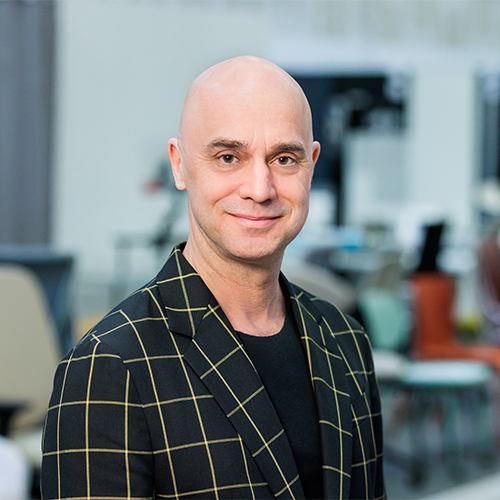Mårten Claesson
Mårten Claesson was born in Lidingö, Sweden, in 1970. After studying at the Vasa Technical College in Stockholm in the department of construction engineering and at the Parsons School of Design in New York in the departments of architecture and product design, he graduated in 1994 with an MFA degree from Konstfack, the University College of Arts, Crafts and Design in Stockholm. He is co-founder of the Swedish design partnership Claesson Koivisto Rune, which is multidisciplinary in the classic Scandinavian way and which pursues the practice of both architecture and design. Mårten Claesson is also a writer and lecturer in the field of architecture and design.

Red Dot in an interview with Mårten Claesson
You studied product design, civil engineering and architecture. Which genre appeals to you most?
In a way, I see architecture as the “mother of design”, but in the broader sense. By that I mean not just in the context of buildings, but as a mindset in which every object has a relationship with its surroundings: for example, a drinking glass on a table in a room of a house that is part of a city. When we design a glass, we always look at how well it works in the given context. This makes the process more complex – just like in architecture – but at the same time it represents an appealing challenge.
The multidisciplinary connection between architecture and design is very natural in Scandinavia. Astonishingly, in many other countries, clearer boundaries are drawn. How would you argue in favour of the “Scandinavian model”?
To be honest, design and architecture have also become detached from each other in Scandinavia. But I’d say this unfortunate process started comparatively late here. The advantage of a closer connection between the two genres is that they are inextricably linked in real life. Even though I see the advantages of specialising in a particular area of design, they are outweighed by the risk of losing sight of the big picture.
Your studio, Claesson Koivisto Rune, has an incredibly diverse portfolio. Would a specialisation in one particular area be simply too boring for you?
When we’re commissioned to do something we’ve never done before, it puts us on our toes, and we love that feeling. But it is also a question of the different processes. In architecture, a project can typically take years to complete with so many experts and consultants involved. Design is often much more straightforward – one manufacturer, one designer, one decision. The entire process only takes a few months. Both have their advantages, and it’s great to be able to move between the two areas on a daily basis.
The proximity to interior design is obvious. What appeals to you about designing living spaces? Is it also the interaction of the objects?
Interior design is architecture, but on a scale of 1:20 instead of 1:100, so it’s closer to the human scale. When you work with a private client, you get the sense of helping someone realise their dream of a better life. I’d say that industrial design is also about improving the lives of users, but that’s not necessarily the main focus during the process. Industrial design is more about price, sales figures and production costs.
Do you still see objects during the Red Dot jury sessions that surprise you?
Every year, I see great designs at the Red Dot jury sessions. Only a few of the thousands of objects really surprise me, but that’s in the nature of things. It is amazing how human creativity and design talent are constantly reinventing themselves, no matter what era or epoch we find ourselves in. Design is a great way to observe the power of human capability.
Your own studio has won countless awards. Is this kind of external feedback helpful to your own evolution?
An award always gives us a boost. There’s no denying that. But I’d say it gives the manufacturer an even bigger boost because it’s a kind of “official” approval. Any manufacturer can claim their product is good, but an award is an additional external confirmation of that. I also think this is particularly important in a field that cannot be measured in exact units because the award can be viewed as non-subjective.
In 2021, King Carl XVI Gustaf of Sweden presented the Prince Eugen Medal to your studio. What did that mean for you and your team?
In Sweden, unlike the UK, you can’t be awarded a knighthood for your life’s work. The Prince Eugen Medal is our equivalent, which means it’s the highest official honour. So, obviously, we’re super proud.
Is there a design era that you think deserves a renaissance?
The early to mid-sixties were the peak of modernism. That was the time when the movement had matured from subversive to refined. Fashion, cars, skyscrapers – the world had never looked so perfect.
And what about architecture - which is your favourite epoch?
I’ve come to the conclusion that there is no one architectural epoch or style that stands out above all the rest. It’s all about quality. Andrea Palladio, Frank Lloyd Wright and Herzog & de Meuron represent very different eras, but all produced equally impressive work.
Last but not least, which item would you never want to be without because of its design?
My MGC. A rare vintage British sports car made in 1968 that was a design compromise in many respects, yet still holds such incredible appeal.